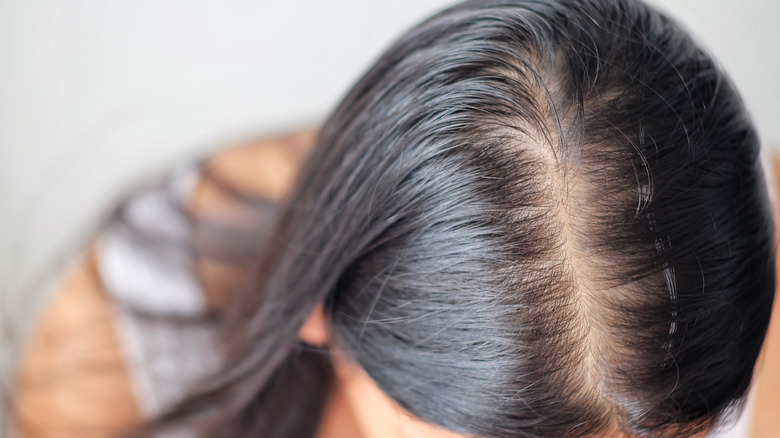Thin Vs. Fine Hair: What's The Difference?
People often use the terms "thin" and "fine" to categorize hair interchangeably — but those descriptors are not the same. It's typically easy to tell if you have naturally "thick" hair. Thick hair tends to tangle more easily but manages to hold curls and volume for longer. On the other hand, figuring out if you have thin or fine hair can be more complicated, and it doesn't help that we confuse these terms almost constantly.
Learning your hair type can be extremely advantageous for choosing the best products to use and styles to ask for in the salon. For instance, the best hairstyles for people with fine hair might not be as easy to style as they would be for those with thick hair. Luckily, we know the way to find out which hair type you have. But before you get too far in that process, it helps to know the difference between thin and fine hair.
It depends on the density and texture of your hair
Thin hair and fine hair are not synonymous, even if people often confuse those descriptions as meaning the same thing. Hair care experts say that the big difference between having "thin" hair versus "fine" hair has to do with two factors. It depends on your hair's density and hair strands' thickness, according to Philip Kinglsey's hair guide. Density means how many hair strands are on your head. For those with thin hair, "that refers to the amount of hair you have," per Eric Gross of Hairfolk Salon in Birmingham, Alabama (via Southern Living). If you don't have a lot of hair, you have "thin hair."
Meanwhile, "fine" hair refers to the texture and diameter of those individual strands. "You can have a lot of fine hair and it would still look like it's lacking volume because the texture is fine and feeble," said stylist Paul Rus, according to Martha Stewart. That means you could have a high-hair density (lots of hair strands) that is fine (hair strands that are small in diameter).
How to style and take care of thin hair
Taking good care of thin hair is incredibly important, especially if you are concerned about the appearance of your scalp and lack of hair. Luckily, you and your stylist can collaborate to find the perfect cut and hair maintenance routine that keeps you confident and your hair healthy. One trending haircut is perfect for the thin-haired girls out there, the U-shaped cut. When the U-shaped cut made its rounds on TikTok, women with thin hair found a great way to maximize their hair's natural volume. Contrary to the traditional one-length cut, this layered look adds shape that translates into volume. "The sides of your hair compared to the back section are much thinner so that U-shape will instantly take that 'stringy' look away while giving you a nice, blunt-looking cut," hairstylist Rachel Selt said (via Allure).
For everyday maintenance, be sparse with shampoo. Shampooing too often can make your thin hair "more brittle," according to Kiehl's, which can lead to shedding — something you definitely don't want if you already don't have as much hair. Kiehl's also recommends using warm instead of burning hot water, conditioning every time you wash your hair, and considering reparative products and serums.
How to style and take care of fine hair
Fine hair can be "thin" — meaning you don't have much of it — or, as confusing as it seems, "thick." In other words, you have lots of strands of hair that are small in diameter. Each of these qualities can affect what styles might work best for you. If you struggle with keeping volume because you have a lot of fine strands of hair, you could pull off a shag haircut that looks effortless, is easy to maintain, and will make your hair look more texturized. You can up the volume by raking through your hair with your fingers and spraying in some dry shampoo.
In addition to using dry shampoo that increases your hair's volume, consider getting a shampoo that promotes hair volume, too. According to New York hairstylist Nunzio Saviano, "Using a volumizing shampoo can help plump up the roots and add nutrients back to depleted strands" (via Real Simple). You could probably bear not washing your hair as often. According to Hair.com, if you have fine hair, aim to wash it only three or four times a week. Whether you have thin hair, fine hair, or a combination of both, you can make small adjustments that maximize your hair's volume and texture.



